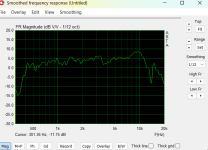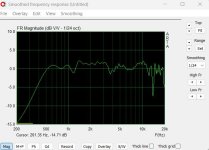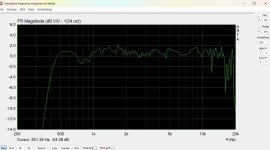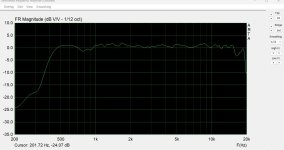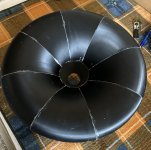I didn't check, unfortunately.How well converged were the solutions with spurious modes?
The cubical woofer enclosure with an as long as possible center-to-center distance to the horn appears to be the best possible design approach in the light of what @bmc0 demonstrated. An adjecent surface of with a significant area, be it below or above the woofer, flat or concave, will create a significant power peak.
Currently, a 800 Hz crossover is possible with a number of 1-inch compression drivers. It might be pushed down to 700 or even 600 Hz depending on levels and distortion results with some. If someone is going to test this, there is a question that I am interested to hear your experience with: do you hear two different sources when a bass instrument like a bass guitar plays the scale downward or upward?
This might be a limiting design factor. If this is the case we can at least save ourselves the troubles to work into that direction.
Currently, a 800 Hz crossover is possible with a number of 1-inch compression drivers. It might be pushed down to 700 or even 600 Hz depending on levels and distortion results with some. If someone is going to test this, there is a question that I am interested to hear your experience with: do you hear two different sources when a bass instrument like a bass guitar plays the scale downward or upward?
This might be a limiting design factor. If this is the case we can at least save ourselves the troubles to work into that direction.
Hi, yeah, exactly as I wrote earlier😉 if one uses proper c-c to smoothen the transition, plan listening height between the sources and listening distance doesn't matter as one is always equidistant to both. Separation is audible when near by and at an angle though.
This is quite big speaker in general so I think it is not good plan for small spaces and short listening distances, would be bad compromise in this sense. If big c-c and small objects is something one wants to avoid, make it look good and big bass box and so on, and just deal with the power peak if it bothers. Speakers are always a compromise, just make the most suitable solution to your application.
This is quite big speaker in general so I think it is not good plan for small spaces and short listening distances, would be bad compromise in this sense. If big c-c and small objects is something one wants to avoid, make it look good and big bass box and so on, and just deal with the power peak if it bothers. Speakers are always a compromise, just make the most suitable solution to your application.
Last edited:
This assumes that it's actually objectionable in practice. It's possible that the cure is worse than the disease, so to speak.The cubical woofer enclosure with an as long as possible center-to-center distance to the horn appears to be the best possible design approach in the light of what @bmc0 demonstrated.
What I primarily intended to point to were the merrits of a square baffle, not cubical enclosure. The backside and depth of the enclosure is well suited to differ in dimension from the baffle and counteract an unwanted adding-up of diffraction effects.
The direct reflection from the baffle creates a much stronger effect than around-the-enclosure diffraction.
The direct reflection from the baffle creates a much stronger effect than around-the-enclosure diffraction.
I’m running into issues, every ABEC project has errors in the observation script.
I’ve found a workaround by editing the observation.txt file: changing Polar to Directivity and removing the NormalizingAngle.
Any idea what might be causing this?
I’m using ATH-latest-231015 and ABEC 3.6.0 b07.
Here is a screenshot from ABEC, using the tritonia-s script.

I’ve found a workaround by editing the observation.txt file: changing Polar to Directivity and removing the NormalizingAngle.
Any idea what might be causing this?
I’m using ATH-latest-231015 and ABEC 3.6.0 b07.
Here is a screenshot from ABEC, using the tritonia-s script.
It looks like you have a typo in your config file. Note the error "'Inclination' is not a valid integer value."
That error tends to indicate that ABEC is trying to interpret the word "inclination" instead of the numerical value that should follow.
Also, I keep a few different versions of ATH installed, because sometimes an option will work on one version but not the next. For instance, "rollback" works on old versions but not new ones.
That error tends to indicate that ABEC is trying to interpret the word "inclination" instead of the numerical value that should follow.
Also, I keep a few different versions of ATH installed, because sometimes an option will work on one version but not the next. For instance, "rollback" works on old versions but not new ones.
So, how does it perform? 🙂It printed fine. I've sprayed it with epoxy primer - perfect for the job. Looks cool.
I printed mine, it went surprisingly easily (0.6mm nozzle) -
BTW, a 3-channel 80mm long ESP for the 760Neo looks also very good on paper. I'm going to try that as well, there's even a possibility to continue with the existing phase plug channels (i.e. to make the vanes at the same positions). I've no idea if it can be beneficial (Axi2050 also offers this option directly, I would only have to modify the existing plug).
I think the shorter it is, the bigger chance it will work as predicted. The above one (2") is only 50 mm long.
Last edited:
It looks like you have a typo in your config file. Note the error "'Inclination' is not a valid integer value."
That error tends to indicate that ABEC is trying to interpret the word "inclination" instead of the numerical value that should follow.
Also, I keep a few different versions of ATH installed, because sometimes an option will work on one version but not the next. For instance, "rollback" works on old versions but not new ones.
I'm wondering if it's ABEC that's not reading the observation script correctly. How does a typical observation script look like? Here is the one I get when I run the tritonia-m script through ath and produces the errors mentioned before.
Are the previous versions ATH available somewhere?
Code:
Driving_Values
DrvType=Acceleration; Value=1.0
401 DrvGroup=1001 Weight=1 Delay=0ms // 0.00 dB
Radiation_Impedance
BodeType=Complex; GraphHeader="RadImp"
Range_min=0; Range_max=2; RadImpType=Normalized
402 1001 1001 ID=8001
BE_Spectrum
PlotType=Polar; GraphHeader="PM_SPL_H"
BodeType=LeveldB; Range_max=5; Range_min=-45
PolarRange=0,180,37
BasePlane=zx
Distance=2m
NormalizingAngle=10
501 Inclination=0 ID=5001
BE_Spectrum
PlotType=Polar; GraphHeader="PM_SPL_V"
BodeType=LeveldB; Range_max=5; Range_min=-45
PolarRange=0,180,37
BasePlane=zx
Distance=2m
NormalizingAngle=10
502 Inclination=270 ID=5002That was the issue! I thought I was using the latest version, but the ABEC files opened on an older version of abec that was hiding somewhere on the PC. There are no errors when using ABEC (3.6.0 b7). Thanks for your help!It seems that you're actually using some old version of ABEC, as "Polar" replaced "Directivity" in the ABEC scripts at some point.
The Tritonia scripts should definitely work flawlessly with both the latest ABEC (3.6.0 b7) and Ath.
Can Ath4 be used with a super formula to basically created a horn exit with a rectangular obstruction in the middle?
I have been working on my long term project of the unitized image waveguide from Patrick Bateman’s design thread. I measure the horn down to about 500hz, but need to transition it to a midbass horn. I was thinking of a hybrid approach to control directivity to 200hz. Basically put the waveguide (about 10” wide) into a phase plug in the center of the midbass waveguide. The “phase plug” would be abruptly terminated at the exit so it basically a horn with a rectangular obstruction in the middle - I.e. a rectangular ring radiator. The length and width or the ring would be 0.4-0.6x the wavelength of 350hz and thus have destructive interference in the horn to narrow directivity similar to the Gorbachev and Merle perhaps in filters and woofer spacing to achieve narrower directivity. Can this be done? Thanks!
I have been working on my long term project of the unitized image waveguide from Patrick Bateman’s design thread. I measure the horn down to about 500hz, but need to transition it to a midbass horn. I was thinking of a hybrid approach to control directivity to 200hz. Basically put the waveguide (about 10” wide) into a phase plug in the center of the midbass waveguide. The “phase plug” would be abruptly terminated at the exit so it basically a horn with a rectangular obstruction in the middle - I.e. a rectangular ring radiator. The length and width or the ring would be 0.4-0.6x the wavelength of 350hz and thus have destructive interference in the horn to narrow directivity similar to the Gorbachev and Merle perhaps in filters and woofer spacing to achieve narrower directivity. Can this be done? Thanks!
Is there a guide showing how people are exporting VACs polar data into VituixCAD? Tried it a few different ways but it doesn't exactly seem intuitive.
maybe this helps https://www.diyaudio.com/community/...-design-the-easy-way-ath4.338806/post-7189006Tried it a few different ways but it doesn't exactly seem intuitive.
Exactly what I was looking for. Thank you!
The Liquid nails for subfloor worked great, I found something called Sudal 26A and it went smooth. Tight joints, fills nicely. Some very tiny gaps that need to be filled(needed or not? Generally hate any air pockets..) and I am now considering what to use to seal the surface and use it as a base for the paint.
Thanks again everybody!
Thanks again everybody!
Attachments
In fact, I haven't seen any spurious solutions even though I'm just using a basic null field formulation (i.e. no NUC scheme).
There are wiggles in your first plot that look like small unresolved spurious modes which will likely get more noticeable if you move closer to the body and/or resolve the frequency.
Below is the frequency sweep for a pulsating sphere using a fairly coarse grid of 540 elements. The first plot shows the first few spurious modes arising from the basic approach. The second shows the result of combining the governing equation with it's normal derivative. This shows that bempp-cl can run without spurious modes. The deviation from the exact solution is due to the low order approximation and not using enough elements.
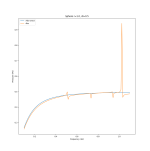
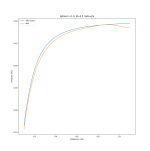
The biggest problem I am having is that it is just too slow. The basic approach took 506 seconds for a frequency sweep on my machine and the enhanced took 1324 seconds. During the sweep all threads were in use but with the load varying between 25-75%. In contrast the basic C code I was using as a check took 5.2 seconds for a sweep with all threads used at 100%. Bempp-cl is a hundred times slower than I would expect (on my machine and my installation).
Here is an equivalent result from the basic code I am messing about with. Note that halving the mesh size brings the prediction a lot closer to the exact solution. The simulation includes an old simple fix for spurious modes but, interestingly, it has only removed 2 of the 4. The two it removed are the internal resonances of the sphere at frequencies around 0.5 and 1.0. Whatever, just including it to support that bempp-cl is producing the expected results (just very slowly).
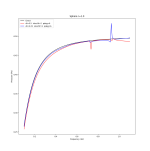
- Home
- Loudspeakers
- Multi-Way
- Acoustic Horn Design – The Easy Way (Ath4)
